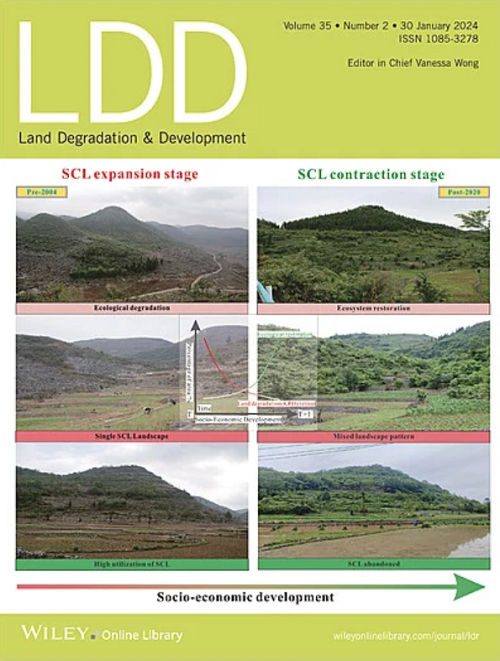刈割对草地根系生物量、土壤特性、微生物生物量和微生物多样性的影响:元分析
IF 3.6
2区 农林科学
Q2 ENVIRONMENTAL SCIENCES
引用次数: 0
摘要
割草是草地管理中常见的做法,通过去除地上生物量来影响根系生物量、土壤性质和微生物。然而,割草对这些因素的影响尚未得到全面的研究。在这项研究中,我们综合了103份全球出版物的1103份现场观测数据,评估了刈割对草地根系生物量、土壤性质、微生物生物量和多样性的总体影响,并评估了刈割对草地类型、刈割持续时间和残茬高度的影响。结果表明,刈割时间显著影响根系生物量,随刈割时间的增加,影响由正向负转变。此外,刈割对不同草地类型无机氮(IN)的影响也存在差异,在半湿润/湿润草地有所降低,而在干旱/半干旱草地则保持不变。茬高对铵态氮(NH4+-N)有影响,中、低茬高对铵态氮的影响减小,高茬高对铵态氮的影响不大。刈割对微生物生物量氮(MBN)的影响因草地类型和茬高而异。在半湿润/湿润草地和高茬高条件下,MBN呈下降趋势,而在干旱/半干旱草地和中、低茬高条件下,MBN保持不变。此外,刈割对微生物总生物量没有影响,但降低了革兰氏阳性菌、革兰氏阴性菌和丛枝菌根真菌的生物量,降低了细菌Shannon多样性指数,提高了真菌Simpson多样性指数。总体而言,该荟萃分析提供了草地生态系统如何响应刈割的见解,特别是在根系生物量、土壤性质、微生物生物量和多样性方面。它还强调了因地制宜的草地管理策略的必要性。本文章由计算机程序翻译,如有差异,请以英文原文为准。
Effects of Mowing on Root Biomass, Soil Properties, Microbial Biomass, and Microbial Diversity in Grasslands: A Meta-Analysis
Mowing is a common practice in grassland management, impacting root biomass, soil properties, and microorganisms by removing aboveground biomass. However, the effects of mowing on these factors have not been thoroughly reviewed. In this study, we evaluated the overall impact of mowing on root biomass, soil properties, microbial biomass, and diversity grasslands by synthesizing 1103 field observations from 103 global publications and assessed whether the effects of mowing varied with grassland type, mowing duration, and stubble height. Results revealed that mowing duration significantly influenced root biomass, transitioning from positive to negative effects with increased duration. Moreover, the effect of mowing on inorganic nitrogen (IN) differed among grassland types, decreasing in semi-humid/humid grasslands but remaining unchanged in arid/semi-arid ones. Stubble height impacted ammonium nitrogen (NH4+-N), decreasing under medium and low stubble height but not under high stubble height. The effect of mowing on microbial biomass nitrogen (MBN) varied with grassland type and stubble height. MBN decreased in semi-humid/humid grasslands and under high stubble height but remained unchanged in arid/semi-arid grasslands or under medium and low stubble height. Additionally, mowing did not change the total microbial biomass, but decreased the biomass of gram-positive bacteria, gram-negative bacteria, and arbuscular mycorrhizal fungi, as well as the bacterial Shannon diversity index, and increased the fungal Simpson diversity index. Overall, this meta-analysis provides insights into how grassland ecosystems respond to mowing, particularly in terms of root biomass, soil properties, microbial biomass, and diversity. It also highlights the necessity for site-specific grassland management strategies.
求助全文
通过发布文献求助,成功后即可免费获取论文全文。
去求助
来源期刊

Land Degradation & Development
农林科学-环境科学
CiteScore
7.70
自引率
8.50%
发文量
379
审稿时长
5.5 months
期刊介绍:
Land Degradation & Development is an international journal which seeks to promote rational study of the recognition, monitoring, control and rehabilitation of degradation in terrestrial environments. The journal focuses on:
- what land degradation is;
- what causes land degradation;
- the impacts of land degradation
- the scale of land degradation;
- the history, current status or future trends of land degradation;
- avoidance, mitigation and control of land degradation;
- remedial actions to rehabilitate or restore degraded land;
- sustainable land management.
 求助内容:
求助内容: 应助结果提醒方式:
应助结果提醒方式:


